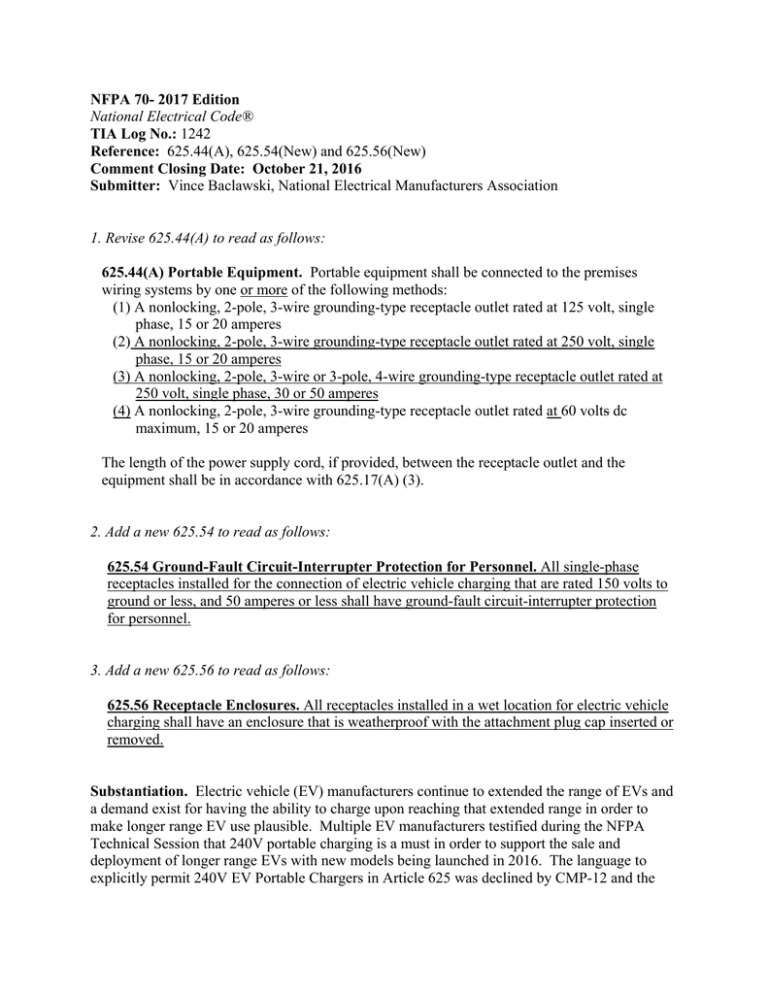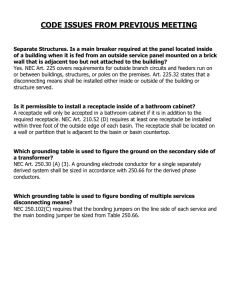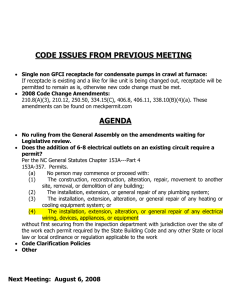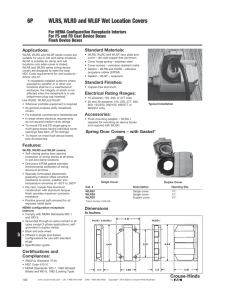NFPA 70- 2017 Edition National Electrical Code® TIA Log No.: 1242
advertisement

NFPA 70- 2017 Edition National Electrical Code® TIA Log No.: 1242 Reference: 625.44(A), 625.54(New) and 625.56(New) Comment Closing Date: October 21, 2016 Submitter: Vince Baclawski, National Electrical Manufacturers Association 1. Revise 625.44(A) to read as follows: 625.44(A) Portable Equipment. Portable equipment shall be connected to the premises wiring systems by one or more of the following methods: (1) A nonlocking, 2-pole, 3-wire grounding-type receptacle outlet rated at 125 volt, single phase, 15 or 20 amperes (2) A nonlocking, 2-pole, 3-wire grounding-type receptacle outlet rated at 250 volt, single phase, 15 or 20 amperes (3) A nonlocking, 2-pole, 3-wire or 3-pole, 4-wire grounding-type receptacle outlet rated at 250 volt, single phase, 30 or 50 amperes (4) A nonlocking, 2-pole, 3-wire grounding-type receptacle outlet rated at 60 volts dc maximum, 15 or 20 amperes The length of the power supply cord, if provided, between the receptacle outlet and the equipment shall be in accordance with 625.17(A) (3). 2. Add a new 625.54 to read as follows: 625.54 Ground-Fault Circuit-Interrupter Protection for Personnel. All single-phase receptacles installed for the connection of electric vehicle charging that are rated 150 volts to ground or less, and 50 amperes or less shall have ground-fault circuit-interrupter protection for personnel. 3. Add a new 625.56 to read as follows: 625.56 Receptacle Enclosures. All receptacles installed in a wet location for electric vehicle charging shall have an enclosure that is weatherproof with the attachment plug cap inserted or removed. Substantiation. Electric vehicle (EV) manufacturers continue to extended the range of EVs and a demand exist for having the ability to charge upon reaching that extended range in order to make longer range EV use plausible. Multiple EV manufacturers testified during the NFPA Technical Session that 240V portable charging is a must in order to support the sale and deployment of longer range EVs with new models being launched in 2016. The language to explicitly permit 240V EV Portable Chargers in Article 625 was declined by CMP-12 and the NFPA Membership at the Technical Session. The two primary reasons were to address the electrical safety of a person plugging and unplugging a 250V cord cap into a receptacle in a wet or damp environment by requiring GFCI and the need for an in-use cover for 250V receptacle outlets serving EV charging equipment. The 2017 NEC partially addressed the GFCI protection requirement for 250V receptacles in locations other than dwellings (NEC 210.8(B)). This proposal seeks to address the GFCI protection gap along with the in-use cover in order to support the inclusion of 240V portable EV charging in NEC 625.44(A). Emergency Nature. The proposed TIA intends to offer to the public a benefit that would lessen a recognized (known) hazard or ameliorate a continuing dangerous condition or situation. The proposed TIA intends to correct a circumstance in which the revised NFPA Standard has resulted in an adverse impact on a product or method that was inadvertently overlooked in the total revision process or was without adequate technical (safety) justification for the action. The introduction of longer range EVs this year (2016) accompanied by 240V portable chargers means the NEC needs to recognize the chargers and address public safety interface concerns that can be accomplished today. The 2017 NEC will create an unnecessary hardship on the Electric Vehicle industry by failing to recognize and address the safety concerns voiced at the NFPA Technical Session. The technology exists to address these safety concerns. CMP-2 actually introduced GFCI protection on 250V receptacle outlets and then removed it from dwellings units. This TIA proposes to recognize the EV 250V portable charging technology in order to alleviate a hardship on the EV industry while addressing the publicly conveyed safety concerns by introducing the GFCI protection and in-use cover requirements on the receptacle outlets for EV charging. The 2017 NEC must recognize the needs of the EV industry by addressing the safety concerns to support the technology and not wait another 3 years. Anyone may submit a comment by the closing date indicated above. To submit a comment, please identify the number of the TIA and forward to the Secretary, Standards Council, 1 Batterymarch Park, Quincy, MA 02169‐7471.



